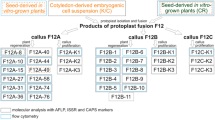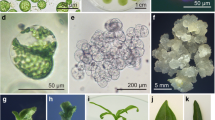Summary
Protoplast fusions between Nicotiana tabacum and N. paniculata and between N. tabacum and N. sylvestris were obtained by polyethylene glycol and Ca(NO3)2 treatment. The protoplasts of one parent originated from cell suspensions, while the protoplasts of the other originated from leaf mesophyll. The heterokaryons were detectable by their intermediate phenotype, namely the green chloroplasts from mesophyll and the dense cytoplasm from suspension cells. They were isolated with micropipettes immediately after fusion using a micromanipulator and were transferred into a protoplast suspension of an auxotrophic cell line serving as a nursery. This mutant is not able to utilize nitrate and had to be supplemented with amino acids. The somatic hybrids were selected by a stepwise reduction of the supplements, which caused the death of the mutant cell colonies, while the autotrophic somatic hybrids continued to grow. The hybrid character of the selected colonies was confirmed by isoenzyme investigations.
Similar content being viewed by others
Literature
Binding, H. (1974): Regeneration von haploiden und diploiden Pflanzen aus Protoplasten von Petunia hybrida. Z. Pflanzenphysiol. 74, 327–356
Brewbaker, J.L.; Upadhya, M.D.; Mäkinen, Y.; MacDonald, T. (1968): Isoenzyme polymorphism in flowering plants. III. Gel electrophoretic methods and applications. Physiol. Plant. 21, 930–940
Gamborg, O.L.; Miller, R.A.; Ojima, K. (1968): Nutrient requirements of suspension cultures of soybean root cells. Exp. Cell Res. 50, 151–158
Gebhardt, C.; Schnebli, V.; King, P.J. (1981): Isolation of biochemical mutants using haploid mesophyll protoplasts of Hyoscyamus. II. Auxotrophic and temperature-sensitive clones. Planta 153, 81–89
Gleba, Y.Y.; Hoffmann, F. (1978): Hybrid cell lines Arabidopsis thaliana + Brassica campestris: no evidence for specific chromosome elimination. Mol. Gen. Genet. 165, 257–264
Kao, K.N. (1977): Chromosomal behaviour in somatic hybrids of soybean — Nicotiana glauca. Mol. Gen. Genet. 150, 225–230
King, J.; Horsch, R.B.; Savage, A.D. (1980): Partial characterization of two stable auxotrophic cell strains of Datura innoxia Mill. Planta 149, 480–484
Krumbiegel, G.; Schieder, O. (1979): Selection of somatic hybrids after fusion of protoplasts from Datura innoxia Mill. and Atropa belladonna L. Planta 145, 371–375
Marton, L.; Dung, T.M.; Menczel, R.R.; Maliga, P. (1982): Nitrate reductase deficient cell lines from haploid protoplast cultures of Nicotiana plumbaginifolia. Mol. Gen. Genet. 182, 301–304
Menczel, L.; Lázár, G.; Maliga, P. (1978): Isolation of somatic hybrids by cloning Nicotiana heterokaryons in nurse culture. Planta 143, 29–32
Müller, A.; Grafe, R. (1978): Isolation and characterization of cell-lines of Nicotiana tabacum lacking nitrate reductase. Mol. Gen. Genet. 161, 67–76
Ninnemann, H.; Jüttner, F. (1981): Volatile substances from tissue cultures of potato, tomato and their somatic fusion products — comparison of gas Chromatographic patterns for identification of hybrids. Z. Pflanzenphysiol. 103, 95–107
Patnaik, G.; Cocking, E.C.; Hamill, J.; Pental, D. (1982): A simple procedure for the manual isolation and identification of plant heterokaryons. Plant Sci. Lett. 24, 105–110
Roth, E.J.; Lark, K.G. (1982): Isolation of an auxotrophic cell line of soybean (Glycine max) which requires asparagine or glutamine for growth. Plant Cell Rep. 1, 157–160
Scandalios, J.G. (1969): Genetic control of multiple molecular forms of enzymes in plants. A review. Biochem. Genet. 3, 37–74
Schieder, O. (1975): Regeneration von haploiden und diploiden Datura innoxia Mill. Mesophyll-Protoplasten zu Pflanzen. Z. Pflanzenphysiol. 76, 462–466
Schieder, O.; Vasil, I.K. (1980): Fusion and somatic hybridization. In: Recent advances in plant cell and tissue culture (ed. Vasil, I.K.). Int. Rev. Cytol. (Suppl.) 11B, 21–46. New York: Academic Press
Strauss, A.; Bucher, F.; King, P.J. (1981): Isolation of biochemical mutants using haploid mesophyll protoplasts: I A NO -3 non-utilizing clone. Planta 153, 75–80
Wenzel, G.; Schieder, O.; Przewoźny, T.; Sopory, S.K.; Melchers, G. (1979): Comparison of single cell culture derived Solanum tuberosum L. plants and a model for their application in breeding programs. Theor. Appl. Genet. 55, 40–55
Author information
Authors and Affiliations
Additional information
Communicated by G. Wenzel
Rights and permissions
About this article
Cite this article
Hein, T., Przewoźny, T. & Schieder, O. Culture and selection of somatic hybrids using an auxotrophic cell line. Theoret. Appl. Genetics 64, 119–122 (1983). https://doi.org/10.1007/BF00272718
Received:
Issue Date:
DOI: https://doi.org/10.1007/BF00272718




